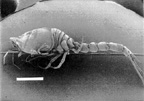 |
 |
|
Introduction
| Cumaceans are small crustaceans, generally 1-10mm in size, which occur from tidal to abyssal depths in marine (and brackish) waters throughout the world. They are found in the first few cms of sand or sand/mud substrates; while they may be locally abundant, their distributions are patchy. Cumaceans feed on microorganisms and organic matter and are, in turn, consumed by bottom feeding organisms including a number of fishes. |



|
|
These malacostracans are distinguished by a combination of features including a large carapace which covers many thorasic somites, a narrow, long abdomen, a forked tail,
and, in many families, a telson. The sexes are conspicuously dimorphic: females lack pleopods (with one exception, of course!) and have a large brood chamber.
The carapace is ornamented in many lineages and appendages are generally highly modified. The morphology of cumaceans is sufficiently distinctive that members of the order are
easy to recognize. |
Citation
Usage of data from the Cumacea World Database in scientific publications should be acknowledged by citing as follows:- Watling, L.; Gerken, S. (2025). World Cumacea Database. Accessed at https://www.marinespecies.org/cumacea on 2025-12-20. doi:10.14284/354
Individual pages are individually authored and dated. These can be cited separately: the proper citation is provided at the bottom of each page.
Page generated on 2025-12-20 15:02:19 - contact: Les Watling